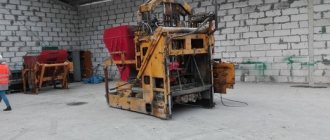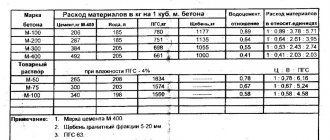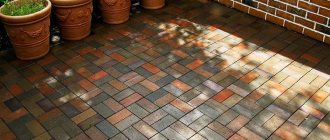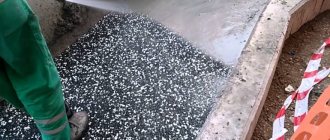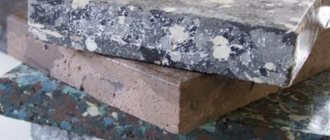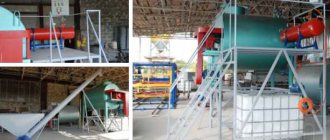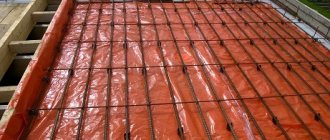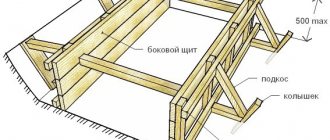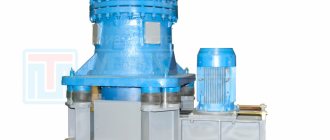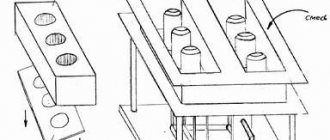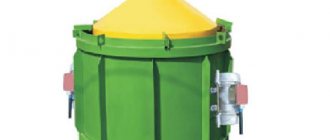The production of reinforced concrete products (RCP) on an industrial scale is carried out in factories or landfills. Factories are enterprises in which the main technical processes take place in covered workshops. Only part of the technological activities are carried out at testing sites, indoors. Most operations - molding, drying, finishing work - are carried out either in open areas or in specialized equipment located in open space. There are three main methods for the production of reinforced concrete products: flow-aggregate, conveyor, bench, a variation of which is cassette.
Assortment of concrete products
The production technology of reinforced concrete products is selected in accordance with their types and sizes. The following varieties are most in demand in construction and architecture:
- FBS - solid foundation blocks. They are used for the construction of prefabricated foundations and arrangement of basements. The large dimensions of the blocks significantly reduce construction time.
- Wall panels – single- and multi-layer. Made from light and heavy concrete.
- Floor slabs. These products are used for the installation of interfloor ceilings. During operation, they experience serious loads, therefore, in the production of such products, only high-strength concrete and reinforcing bars are used. Plates can be made with internal voids.
- Road slabs. They are used in the construction of runways and road surfaces.
- Reinforced concrete piles. The products are in demand when constructing pile foundations on problematic soils.
- Concrete supports and fences. Such products are popular in private housing construction, so representatives of small businesses are engaged in their production en masse.
- Decorative elements used for finishing facades and landscape decoration.
In addition to the above products, other types of reinforced concrete products are also produced at factories and landfills, such as: rings for wells, side stones, trays for stormwater systems, lighting poles, pipes, flower beds, urns, flower boxes and others.
The concept of monolithic and prefabricated concrete and reinforced concrete
The concept of monolithic and prefabricated concrete and reinforced concrete
In modern construction, the main structures of industrial, civil, agricultural and residential buildings and structures are made from concrete and reinforced concrete, as well as hydraulic structures are erected, roads and airfields are paved, etc. The massive use of concrete and reinforced concrete in all branches of construction is explained by their advantage over other materials: the service life of structures in most cases is significantly longer than structures made of metal, wood and other materials; most (up to 90%) of the materials (aggregates, water) used for the preparation of concrete and reinforced concrete are local, and therefore the cost of structures is low; using various starting materials and manufacturing methods, it is possible to obtain concrete and reinforced concrete with different physical and mechanical properties; from concrete and reinforced concrete it is possible to manufacture products of any size and shape (thin-walled and large-sized) gadflies, shells, etc.
In modern construction, monolithic concrete and reinforced concrete structures are used, erected directly at the site of their placement in buildings and structures according to the project, and prefabricated ones, manufactured at enterprises or construction sites and installed at the construction site.
The production of monolithic structures, carried out outdoors in newly developed territory and often at high altitudes, requires significant labor and consumption of materials for the construction of formwork, scaffolding and other devices. The concreting process on a construction site is difficult to mechanize and automate. In addition, in winter, the production of monolithic structures is associated with serious difficulties (heating the mixture, etc.).
The production of prefabricated structures in a factory environment due to complete mechanization and automation of the technological process can significantly reduce the consumption of materials (including for formwork), the labor intensity of manufacturing, improve the quality of structures, and also greatly reduce the time required for work on the construction site and create conditions for rhythmic construction throughout the year, regardless of climatic conditions, which ultimately leads to a reduction in construction costs.
In addition to the undoubted advantages, prefabricated reinforced concrete structures also have a number of disadvantages. Thus, the specific consumption of reinforcement for prefabricated elements in some cases is greater than for monolithic ones. This is explained by the additional costs of metal for the installation of special reinforcement designed to absorb stresses that may arise during transportation and installation, as well as for connecting prefabricated structures to each other. When organizing the production of prefabricated structures, significant capital investments are required for the construction of special enterprises equipped with relatively complex metal-intensive and energy-intensive equipment.
Schematic diagram of the manufacture of reinforced concrete products
The main stages of the manufacturing process of reinforced concrete products:
- assembly of reinforcing flat or volumetric frames by spot welding or bonding;
- production of concrete mixture;
- molding of reinforced concrete products;
- thermal and humidity treatment of products;
- decorative surface finishing.
Depending on the type and purpose of concrete products, additional measures may be carried out, for example, laying insulation during molding or assembling elements.
Manufacturing
Any production process is divided into several stages. This is the preparation of the concrete itself, installation of the reinforcing frame, molding of the product, processing at the appropriate temperature and humidity and, if necessary, facing work. The order of stages varies depending on the type of structure being manufactured.
What is the technology for manufacturing reinforced concrete, monolithic concrete, pre-stressed reinforced concrete at the factory, read on.
Reinforced concrete production technology
There are 3 main manufacturing methods. Of these, aggregate-flow and conveyor are classified as production in portable forms, and bench type is classified as production without portable forms. The new technology, which involves molding the entire product on a rolling mill, is not yet widespread.
The following video will tell you what extrusion is as a method for producing reinforced concrete:
Aggregate-flow method
Aggregate-flow - the essence of the method is to divide the entire production process into several different operations. The product moves from one unit to another in a random order, determined by their manufacturing method, and is held at each post - the aggregate node of the line - to complete the operation. Delay times vary: mold lubrication, for example, requires only a few minutes, but curing requires several hours.
The undoubted advantage of the method is the ability to simultaneously produce different types of products. Each of them - a pile, a foundation block, a free-flow and pressure pipe, etc., moves only to those posts that are required for manufacturing, without interfering with each other.
In general, the production scheme is the same: lubricating the mold, placing reinforcement - mesh, rods and beams of the required diameter, pouring and curing concrete. Different shapes are used for different products.
Additional equipment may also be required.
- Thus, in the manufacture of free-flow pipes, vibrating platforms are needed to compact concrete in structures.
- And for the production of pressure ones - special installations for the implementation of spiral-transverse reinforcement.
Conveyor method
The same operations are used here, but the movement of products along the line is strictly regulated. The sequence is strictly observed, and the feed rate depends on the operation time. The conveyor method requires complete synchronization; here it is impossible to do without comprehensive mechanization of each stage.
As a rule, parallel to the forming line - that is, lubricating the mold, laying reinforcement and pouring concrete, a thermal and moisture treatment line is organized. The product moves in the opposite direction, passing through special chambers that significantly speed up the concrete hardening process.
Obviously, this method is characterized by very high productivity and allows production to be automated to the maximum extent. Its disadvantage is its specialization: the line is designed to produce a standard product. Most often, wall panels for buildings are produced using the conveyor method.
Bench method
Its distinctive feature is the immobility of its form. The product does not move along the line; on the contrary, the processing equipment is fed to a stationary form - a stand. Thus, with the help of essentially one line, different types of products are manufactured. Each such mold is intended for one or more very similar products.
Based on the type of product, stands are divided into specialized ones - for the production of flights of stairs, for example, or crane beams, and universal ones, in which several similar models are produced. The stands themselves can be collapsible or stationary.
The cassette method is a type of bench method and is classified into a separate group. The line is based on detachable metal stands of various shapes. Reinforcement is placed in them, poured with concrete of the appropriate grade and left to harden. The cassette method allows you to organize the production of very long blocks.
This method, like those described above, allows you to obtain prefabricated and prefabricated reinforced concrete. The production of the monolith is carried out directly on the site.
Read on to learn more about equipment and various installations for drilling holes in reinforced concrete.
Equipment
Equipment for the production of reinforced concrete products is divided into two types: molds and service equipment. An indispensable participant in production is mechanized transport: trolley conveyors moving along rail tracks.
The technological line in general includes the following elements.
- Molding unit - metal forms are used, of various configurations, since complex curved structures are made from concrete.
- Units for preparing reinforcement – cutting and tensioning. The latter can be mechanical or electrically heated. The degree of tension is determined by the parameters of the product.
- Form placement machine is a post at which a concrete distributor places and compacts the concrete mixture.
- Vibrating platform for greater compaction of the material or, conversely, the formation of voids, as, for example, in the manufacture of multi-hollow panels.
- Hardening chambers - slotted, pit or multi-tiered type, for heat treatment of concrete.
In addition, the line may include a number of other units necessary for the production of certain products. For example, when producing pressure pipes, you will also need installations for the production of U-shaped brackets, an apparatus for clamping them, a hydraulic pressing station, a unit for the production of a dividing strip, etc.
Technological lines of different types can be combined. Thus, when producing internal panels, the cassette-conveyor method turns out to be more convenient and profitable.
Read about how to drill a hole in reinforced concrete in the next section.
The following video will tell you more about the equipment for the production of reinforced concrete:
Protection of reinforced concrete structures with polymer materials[ | ]
To protect reinforced concrete structures, special polymer compounds are used to isolate the surface layer of reinforced concrete from the negative influences of the external environment (chemical agents, mechanical stress). To protect reinforced concrete bases, various types of protective structures are used, which make it possible to modify the operational properties of the mineral surface - increase wear resistance, reduce dust separation, impart decorative properties (color and degree of gloss), and improve chemical resistance. Polymer coatings applied to reinforced concrete bases are classified by type: dust-removing impregnations, thin-layer coatings, self-leveling floors, high-fill coatings.
Another method of protecting reinforced concrete structures is to coat the reinforcement with zinc phosphate.[8] Zinc phosphate reacts slowly with a corrosive chemical (such as alkali) to form a stable apatite coating.
To protect reinforced concrete structures from the effects of water and aggressive environments, penetrating waterproofing is also used, which modifies the structure of concrete, increasing its water resistance, which prevents the destruction of concrete structures and corrosion of reinforcement.
Production of reinforced concrete products using the bench method
There are several ways to produce high-quality reinforced concrete products in a stationary plant or mobile site. One of the most popular is the bench method . It is characterized by increased efficiency in the manufacture of high-strength pre-stressed structures. In bench production of reinforced concrete products, elements are molded in stationary, stationary molds. The duration of the technological process directly depends on the length of time the product is kept on the stand - there the reinforced concrete products acquire the necessary strength before shipment to storage areas.
Features of bench manufacturing of reinforced concrete products
The main feature of bench technology is the molding and heat-and-moisture processing of products in stationary forms or on specialized stands. The method provides increased efficiency in the production of massive large-sized products, including: rafters and crane beams, trusses, KZhS type slabs, etc. At all stages of work, molded products remain in a stationary position, production equipment moves independently from one mold to another - this reduces energy consumption during the production process, reduces the number of operations of lifting mechanisms and facilitates the work of operators. The technology also provides for the possibility of assigning one or more technologically similar products to each stand. Depending on the number of standard sizes provided on the stand, production plants can be divided into several specialized categories, including:
- Universal – allow you to produce various technically similar products;
- Specialized - designed for the production of standard products: polygonal trusses, landings and flights, crane beams, etc.
The production of concrete products using bench technology involves the installation of products in different planes and with different levels of placement density: vertically, horizontally, in packages, sequentially. Stands can be completely stationary or collapsible. The latter are universal - they can be moved, depending on production volumes and other production needs.
Advantages of producing concrete products using the bench method
Despite the fact that the bench technology for the production of reinforced concrete products provides for a less rational use of production space, in comparison with the aggregate flow and conveyor methods, it has a number of advantages that are not available for specific technologies:
- Versatility - allows you to produce high-quality products without moving them during the production process. The stand design includes vibrators that ensure compaction of the concrete mixture, as well as steam registers that increase the speed of formation;
- Minimum labor costs – the operator does not need to exert significant effort during the production process;
- Production of any complexity – provides the ability to produce products of any size and complexity. During the production process, molds can be used to produce curved, flat large-sized and other products.
The technology for producing reinforced concrete products using the bench method includes the following stages of work: lubricating the surface of the mold with an oil emulsion, laying the reinforcement cage, pouring concrete mixture, operating vibrators (for uniform distribution and leveling of the mixture), supplying steam to steam registers (to accelerate the process of formation and hardening of the product) .
Where to buy equipment for the production of concrete products using the bench method?
The INTEK manufacturing enterprise specializes in the production of technological lines for the production of concrete products using the bench method. We offer full-fledged production lines and individual components for them: from lubricants for concrete molds, concrete pavers and lifting mechanisms, to instruments for testing the strength of concrete products and machines for working with reinforcement - this allows you to create a completely new production or modernize existing ones. INTEK company employs mobile installation supervision teams that carry out delivery, installation and commissioning of equipment - this gives our customers the opportunity to purchase equipment that is ready for production with assembly and commissioning on their own site. INTEK representatives also train personnel to work on our equipment.
Do you need detailed advice from specialized experts or help in choosing the optimal solution for your production?
Contact INTEK managers and get help from qualified specialists!
History[ | ]
- In 1829, the English engineer Fox implemented a metal-reinforced concrete floor.
- In 1849, in France, Lambeau built a boat from reinforced cement.
- In 1854, W. B. Wilkinson in England received a patent for a fire-resistant reinforced concrete floor.
- In 1861 in France, F. Coignet[en] published a book about 10 years of experience in using reinforced concrete, and in 1864 he built a church from reinforced concrete.
- In 1865, W. B. Wilkinson built a house made of reinforced concrete in England.
- In 1867, J. Monier, who is often considered the “author” of reinforced concrete, received a patent for tubs made of reinforced cement.
- In 1868, J. Monier built a reinforced concrete pool, and from 1873 to 1885 he received patents for a reinforced concrete bridge, reinforced concrete sleepers, reinforced concrete floors, beams, vaults and reinforced concrete pipes.
- In 1875, J. Monier built the first reinforced concrete pedestrian bridge, 16 m long and 4 m wide, spanning the moat of the Marquis de Tilier castle in the French town of Chazle [3].
- In 1877, the first book on reinforced concrete was published by T. Hiatt[en] in the USA.
- In 1884, professor of mechanics I. Bauschinger and engineer G. A. Weiss[de] carried out the first extensive studies in Germany to study the characteristics of the operation of reinforced concrete structures[3].
- From 1884 to 1887 in Moscow, reinforced concrete was used in the construction of flat floors, vaults, and tanks. At the same time, tests of structures were carried out, reinforced concrete floors were installed on metal beams.
- In 1886, in the USA, P. Jackson applied for a patent for the use of prestressing reinforcement in the construction of bridges.
- In 1886-1887, engineer M. Könen[de] in Germany developed the first method for calculating reinforced concrete structures.
- In 1888, a patent for prestress was received in Germany by W. Dering, in 1896 in Austria by I. Mandel, in 1905-1907 in Norway by I. Lund, in 1906 in Germany by M. Koenen.
- In 1891 in Russia, Professor N.A. Belelyubsky completed a five-year cycle of large-scale research on reinforced concrete slabs, beams, arches and bridges[3]. In the same year, the book of engineer D.F. Zharintsev, “A Word about Concrete Buildings,” was published, and in 1893, “Reinforced Concrete Structures.”
- From 1892 to 1899 in France, F. Hennebique implemented more than 300 projects using reinforced concrete.
- In 1895, at the second congress of architects in Russia, A. F. Loleit spoke, who later created the main principles of the modern theory of reinforced concrete.
- In 1899, the engineering council of the ministry officially allowed the use of reinforced concrete in Russia.
- In 1904, the first standards for the design and use of reinforced concrete structures appeared in Germany and Sweden, later, in 1906 - in France, and in 1908 - in Russia.
- In 1908, construction began on the Royal Liver Building
, one of the first high-rise (98 m) reinforced concrete buildings in the world.
In 1912, the first reinforced concrete structure in Russia was built - the Rybinsk Tower.
- In 1913-1916, the first reinforced concrete Church of the Savior of the Image Not Made by Hands was built in Russia in Klyazma[4].
The development of the theory of reinforced concrete in Russia in the first half of the 20th century is associated with the names of A. F. Loleit, A. A. Gvozdev, V. V. Mikhailov, M. S. Borishansky, A. P. Vasilyev, V. I. Murashev, P. L. Pasternak, Ya. V. Stolyarov, O. Ya. Berg and others.
In the 20th century, reinforced concrete became the most common material in construction (see Pietro Nervi) and played a significant role in the formation of such architectural trends as modernism and functionalism.
| This section is missing references to information sources. Information must be verifiable, otherwise it may be questioned and deleted. You may edit this article to include links to authoritative sources. This mark was set on October 9, 2020 . |
